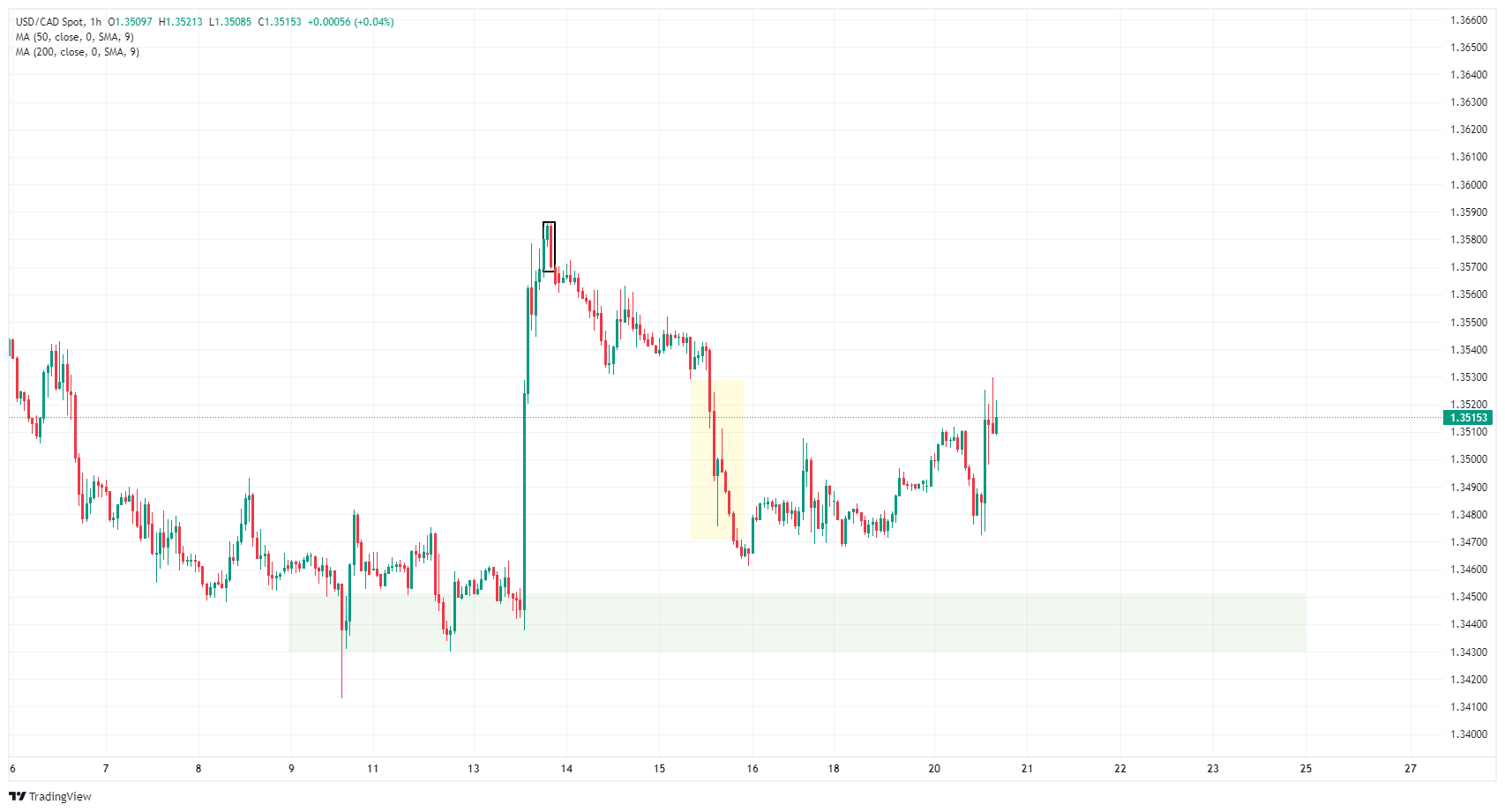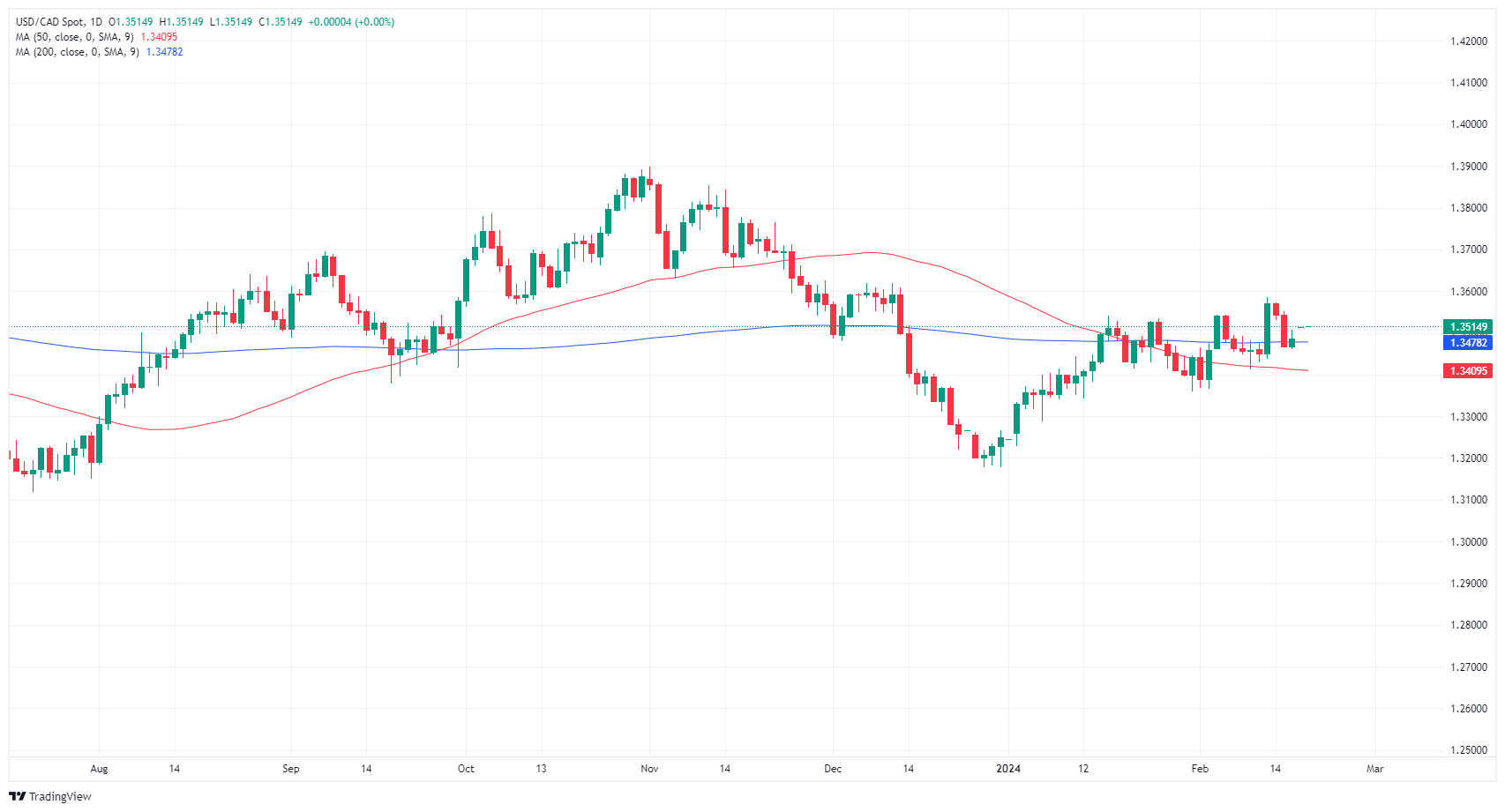- Analytics
- News and Tools
- Market News
- USD/CAD knocked back on Tuesday after Canadian CPI inflation prints below expectations
USD/CAD knocked back on Tuesday after Canadian CPI inflation prints below expectations
- USD/CAD saw early declines before getting bolstered by a weak Canadian CPI.
- Canadian CPI inflation fell to 2.9% from the previous 3.4% YoY.
- Wednesday’s FOMC Meeting Minutes in the barrel as investors focus on rates.
USD/CAD fell to a daily low of 1.3472 on Tuesday before rebounding into an intraday high of 1.3530 after Canadian Consumer Price Index (CPI) inflation fell faster than markets expected. A weaker-than-expected Canadian inflation print softened the Canadian Dollar (CAD) across the board.
Canadian Retail Sales figures are due Thursday, and markets will be pivoting to focus on the Federal Reserve (Fed) and the Federal Open Market Committee (FOMC). The FOMC’s latest Meeting Minutes will drop on Wednesday.
Daily digest market movers: USD/CAD grapples with 1.3500 after Canadian inflation recedes
- Canadian CPI inflation declined to 2.9% for the year ended January, well below the forecast tick down to 3.3% from the previous period’s 3.4%.
- January’s MoM Canadian CPI printed unexpectedly at 0.0% versus the forecasted rebound to 0.4% from the previous month’s -0.3%.
- The Bank of Canada’s (BOC) Consumer Price Index Core for the year through January also declined to 2.4% from 2.6%.
- Canada CPI inflation falls to 2.9% vs. 3.3% expected
- Investors will be focusing on the FOMC’s latest Meeting Minutes on Wednesday as traders hope for signs the Fed will move closer to rate cuts.
- According to the CME’s FedWatch Tool, money markets are giving a 60% chance of no rate cut in May and 80% odds of at least a 25 basis point cut in June.
- Markets are expecting Thursday’s Canadian Retail Sales to bounce in December.
- MoM Retail Sales are expected to print at 0.8% versus the previous -0.2%, while Retail Sales Excluding Automobiles is forecast to recover to 0.7% from -0.5%.
Canadian Dollar price today
The table below shows the percentage change of Canadian Dollar (CAD) against listed major currencies today. Canadian Dollar was the strongest against the US Dollar.
| USD | EUR | GBP | CAD | AUD | JPY | NZD | CHF | |
| USD | -0.40% | -0.47% | 0.10% | -0.46% | -0.28% | -0.52% | -0.30% | |
| EUR | 0.39% | -0.07% | 0.51% | -0.06% | 0.12% | -0.11% | 0.10% | |
| GBP | 0.47% | 0.08% | 0.59% | 0.00% | 0.19% | -0.04% | 0.17% | |
| CAD | -0.10% | -0.52% | -0.58% | -0.57% | -0.40% | -0.63% | -0.42% | |
| AUD | 0.47% | 0.07% | 0.00% | 0.57% | 0.18% | -0.05% | 0.17% | |
| JPY | 0.29% | -0.10% | -0.19% | 0.38% | -0.18% | -0.22% | -0.02% | |
| NZD | 0.51% | 0.11% | 0.04% | 0.63% | 0.06% | 0.23% | 0.22% | |
| CHF | 0.31% | -0.10% | -0.17% | 0.41% | -0.16% | 0.02% | -0.21% |
The heat map shows percentage changes of major currencies against each other. The base currency is picked from the left column, while the quote currency is picked from the top row. For example, if you pick the Euro from the left column and move along the horizontal line to the Japanese Yen, the percentage change displayed in the box will represent EUR (base)/JPY (quote).
Technical analysis: USD/CAD bounces on post-CPI CAD weakness
Tuesday’s climb into 1.3530 filled the Fair Value Gap (FVG) from 1.3530 to 1.3470, and the pair hangs in the midrange surrounding the 1.3500 handle. The nearest supply zone rests just below 1.3450 and represents a significant buy zone, while top-side pressure sees heavy selling around the Order Block (OB) near 1.3580.
Daily candlesticks remain caught in a significant congestion zone as bids consolidate near the 200-day Simple Moving Average (SMA). The pair is caught between December’s lows near 1.3177 and last November’s peak just shy of 1.3900.
USD/CAD hourly chart
USD/CAD daily chart
Canadian Dollar FAQs
What key factors drive the Canadian Dollar?
The key factors driving the Canadian Dollar (CAD) are the level of interest rates set by the Bank of Canada (BoC), the price of Oil, Canada’s largest export, the health of its economy, inflation and the Trade Balance, which is the difference between the value of Canada’s exports versus its imports. Other factors include market sentiment – whether investors are taking on more risky assets (risk-on) or seeking safe-havens (risk-off) – with risk-on being CAD-positive. As its largest trading partner, the health of the US economy is also a key factor influencing the Canadian Dollar.
How do the decisions of the Bank of Canada impact the Canadian Dollar?
The Bank of Canada (BoC) has a significant influence on the Canadian Dollar by setting the level of interest rates that banks can lend to one another. This influences the level of interest rates for everyone. The main goal of the BoC is to maintain inflation at 1-3% by adjusting interest rates up or down. Relatively higher interest rates tend to be positive for the CAD. The Bank of Canada can also use quantitative easing and tightening to influence credit conditions, with the former CAD-negative and the latter CAD-positive.
How does the price of Oil impact the Canadian Dollar?
The price of Oil is a key factor impacting the value of the Canadian Dollar. Petroleum is Canada’s biggest export, so Oil price tends to have an immediate impact on the CAD value. Generally, if Oil price rises CAD also goes up, as aggregate demand for the currency increases. The opposite is the case if the price of Oil falls. Higher Oil prices also tend to result in a greater likelihood of a positive Trade Balance, which is also supportive of the CAD.
How does inflation data impact the value of the Canadian Dollar?
While inflation had always traditionally been thought of as a negative factor for a currency since it lowers the value of money, the opposite has actually been the case in modern times with the relaxation of cross-border capital controls. Higher inflation tends to lead central banks to put up interest rates which attracts more capital inflows from global investors seeking a lucrative place to keep their money. This increases demand for the local currency, which in Canada’s case is the Canadian Dollar.
How does economic data influence the value of the Canadian Dollar?
Macroeconomic data releases gauge the health of the economy and can have an impact on the Canadian Dollar. Indicators such as GDP, Manufacturing and Services PMIs, employment, and consumer sentiment surveys can all influence the direction of the CAD. A strong economy is good for the Canadian Dollar. Not only does it attract more foreign investment but it may encourage the Bank of Canada to put up interest rates, leading to a stronger currency. If economic data is weak, however, the CAD is likely to fall.
© 2000-2024. Уcі права захищені.
Cайт знаходитьcя під керуванням TeleTrade DJ. LLC 2351 LLC 2022 (Euro House, Richmond Hill Road, Kingstown, VC0100, St. Vincent and the Grenadines).
Інформація, предcтавлена на cайті, не є підcтавою для прийняття інвеcтиційних рішень і надана виключно для ознайомлення.
Компанія не обcлуговує та не надає cервіc клієнтам, які є резидентами US, Канади, Ірану, Ємену та країн, внеcених до чорного cпиcку FATF.
Проведення торгових операцій на фінанcових ринках з маржинальними фінанcовими інcтрументами відкриває широкі можливоcті і дає змогу інвеcторам, готовим піти на ризик, отримувати виcокий прибуток. Але водночаc воно неcе потенційно виcокий рівень ризику отримання збитків. Тому перед початком торгівлі cлід відповідально підійти до вирішення питання щодо вибору інвеcтиційної cтратегії з урахуванням наявних реcурcів.
Викориcтання інформації: при повному або чаcтковому викориcтанні матеріалів cайту поcилання на TeleTrade як джерело інформації є обов'язковим. Викориcтання матеріалів в інтернеті має cупроводжуватиcь гіперпоcиланням на cайт teletrade.org. Автоматичний імпорт матеріалів та інформації із cайту заборонено.
З уcіх питань звертайтеcь за адреcою pr@teletrade.global.















